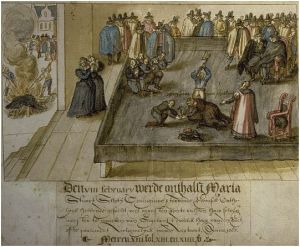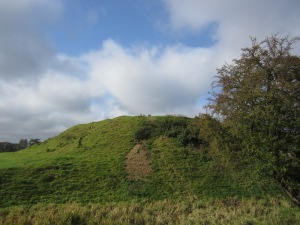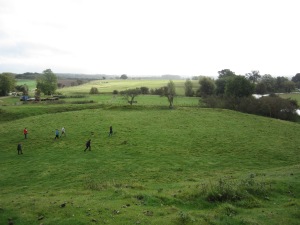
While in the UK on my Mary Queen of Scots tour, we visited many historic sites associated with her life story. This included a trip to Fotheringhay Castle, the scene of her execution on February 8, 1587. There is virtually nothing left of this significant castle but I climbed twenty three feet up to the top of the motte, looking down on the River Nene and across to the village and church and couldn’t help but feel something significant happened here. It turns out this castle has a pretty incredible history encompassing more than just Mary’s execution.

From the north, we entered the site through one of those crisscross gates. The land is a working sheep farm. To the west, there was a picturesque view of the village with the lantern tower of the church in full view. To the east, there was a field but you could tell there were some buildings existed on the spot at one time. Most likely this was the location of the Great Hall where Mary’s execution took place. And to the south the River Nene was lazily flowing by.
It is believed that in the time of the Angles and the Danes there was a ford over the river here before the bridge was built and a mound was erected to oversee and defend the crossing. Domesday Book which was commissioned by William the Conqueror indicates that Judith of Lens owned the manor at Fotheringhay. Judith was a niece of William, being the daughter of his sister Adelaide of Normandy, Countess of Aumale. In 1070, Judith married Earl Waltheof of Huntingdon and Northumbria. They had three children, their eldest daughter being named Maud.

Maud was married to Simon de St. Liz (Senlis), the Earl of Huntingdon and Northampton and he was the first to build a castle at Fotheringhay. This building was most likely made of wood and the present motte and inner bailey are possibly his work. The site was chosen to control an important river crossing but the castle probably was never considered an important military stronghold.
After Simon de St. Liz died in 1113, King Henry I of England arranged for his widow Maud to marry Prince David of Scotland. David gained domination over Maud’s vast estates in England including Fotheringhay. David became King of Scots in 1124 and Fotheringhay was passed on to his son Henry and his grandsons King Malcolm IV and King William the Lion. William gave the castle to his brother David, 8th Earl of Huntingdon who was one of the barons who rebelled against King John in 1215. King John seized Fotheringhay and it was granted to William Marshal, 2nd Earl of Pembroke. He managed to hang on to the property until December 1219 when he gave the castle to King Henry III.

At some point in the thirteenth century, the wooden castle was replaced with stone. Fotheringhay was considered to be part of the dowry of King Henry’s sister Joan when she was married to Alexander II, King of Scots although control was never actually transferred to Alexander. In 1221, custody of the castle was given to Hubert de Burgh, 1st Earl of Kent. William II de Forz, 3rd Earl of Albemarle rebelled against King Henry III and captured Fotheringhay, installing his own garrison. Henry raised a royal army which he took to Fotheringhay and Forz fled rather than meet them. King Henry retained control of the castle and it remained in royal possession until the reign of King Edward II when it was granted to John of Brittany, Earl of Richmond.
When John of Brittany died, his granddaughter Mary St. Pol inherited it. Mary was an interesting woman. In 1321 she married Aymer de Valance, the 2nd Earl of Pembroke and half-brother of King Henry III. Aymer died three years later. They had no children and Mary lived at Fotheringhay in her widowhood devoting herself to religion. In a charter from King Edward III in 1347, Marie was given the authority to found a house of scholars in Cambridge. In memory of her husband, she gave part of her fortune to the university, allowing students to study there and also gave property for them to live in. It is known as Pembroke College and it is the oldest college with an unbroken constitution from its foundation to survive on its original site.
There are historical records from 1341 indicating a stone tower stood on the motte. Also mentioned, within the inner bailey, are two chapels, a great hall, chambers and a kitchen. A group of buildings known as The Manor lay north west of the motte on the site of the Castle Farm. When Mary St. Pol died in 1377, by Royal Grant the castle was passed on to Edmund Langely, the fourth surviving son of King Edward III. Edmund was responsible for spending a great deal of money considerably enlarging and rebuilding the castle. In 1385, Edmund was granted the title of Duke of York and Fotheringhay became the principal seat of the Yorkists. Edmund died in 1402 and was succeeded by his eldest son Edward. Edward died at Agincourt in 1415 supposedly of the heat from being locked in his armor. His dying wish was to be buried in the collegiate church at Fotheringhay and he was interred there in December 1415.
Fotheringhay passed on to Edward’s brother Richard Plantagenet, Earl of Cambridge who was beheaded on suspicion of conspiracy against King Henry V. His son, Richard, Duke of York inherited the castle and it became the favored home of the Yorkist family. King Richard III was born at Fotheringhay in 1452 and Margaret of York, the future Duchess of Burgundy is believed to have been born here in 1446. During the height of the War of the Roses, Richard, Duke of York fought for the throne of England and his wife, Cecily Neville supported her husband’s efforts. Richard died at the Battle of Wakefield along with his son Edmund, Earl of Rutland in December 1460. Cecily’s eldest son did become King Edward IV and she soon received confirmation of her lands and rights. As a widow with enormous personal wealth she continued her patronage of religious houses and the college founded by her husband at Fotheringhay. She outlived her husband by thirty six years and adopted the role of Yorkist matriarch and entertained guests at the castle.
After her daughter Margaret left to marry Charles the Bold, Duke of Burgundy in June of 1468, Cecily moved to Berkhamstead Castle. Fotheringhay was granted to her son King Edward along with other estates. By 1469, King Edward IV and his wife Elizabeth Woodville would occasionally make Fotheringhay their residence. After Cecily Neville died in 1495, King Henry VII gave Fotheringhay to his wife, Elizabeth of York, King Edward IV’s daughter. King Henry VIII gave the castle to his wife Katherine of Aragon as part of her dower and she spent a great deal of money restoring the castle.
Under Queen Mary I, Fotheringhay became a state prison when Edward Courtenay was held in custody there on the charge of being implicated in the rebellion of Sir Thomas Wyatt. Queen Elizabeth I visited Fotheringhay in 1566. She may have remembered this visit when later in her reign she chose the castle as the place to hold the trial and execution of Mary Queen of Scots. The castle site was in a marshy landscape and access was difficult, especially during the heart of winter. The authorities thought it was a secure place and would discourage rash attempts to rescue her.
Execution of Mary Queen of Scots
Mary Queen of Scots was forced to abdicate her throne in July of 1567, turning it over to her infant son who became James VI, King of Scots. For unexplained reasons, after a daring escape from Lochleven Castle, she rode south to England, placing herself at the mercy of Queen Elizabeth I. Queen Elizabeth never forgave Mary for claiming the throne of England and held her in genteel custody. For the nearly twenty years of her captivity, Mary was the subject of many conspiracies and plots to kill Elizabeth and put herself on the throne. Eventually, through the efforts of a spy network orchestrated by Sir Francis Walsingham, Mary was implicated in what was called the Babington Plot. There was written confirmation that Mary was willing to kill Elizabeth and take the throne.

After the intercession of the English Parliament, Mary was brought to trial at Fotheringhay in the Great Hall on October 14 and 15, 1586. She was found guilty on October 25 and sentenced to death. Queen Elizabeth signed the death warrant on February 1, 1587 and her ministers hastened the execution before she changed her mind. Mary was told on February 7 that her execution was set for the next day. Mary spent the night executing her will and attending to her affairs.
There are different accounts of the execution but the tradition is that the executioner botched the job and it took several blows to sever the head. When the executioner went to pick up the head, he picked it up by the hair, only to have the hair remain in his hand and the head roll away as Mary was wearing a wig. One version of the story has one of Mary’s dogs emerging from underneath her skirts, refusing to leave her corpse. Mary’s corpse was kept at the castle until July when it was taken to Peterborough Cathedral and buried there.
A description of the castle exists from 1625. After that, Fotheringhay was abandoned and gradually all its stone masonry and walls were demolished with the materials being used to build other buildings. The Great Hall was stripped of its furnishings in 1628. The staircase Mary Queen of Scots had descended to her execution was used in the Talbot Inn in Oundle and can still be seen there today. The castle was fully gone by the eighteenth century.

A large block of limestone rubble, all that exists of the castle, sits beside the river surrounded by an iron fence. It was put there in 1913. There are three plaques on the fence. One states this is all that remains of Fotheringhay castle. One was placed there by the Stuart History Society and commemorates the death of Mary Queen of Scots. The third plaque was set up by the Richard III Society and commemorates the birth of King Richard. This is a small memento of the momentous events that occurred here. It’s a pity there isn’t more of this historic monument left.
Further reading: “Fotheringhay and Mary Queen of Scots” by Cuthbert Bede, “Cecily Neville, Mother of Kings” by Amy License
[…] S (2015) The History of Fotheringhay Castle. Available from: https://thefreelancehistorywriter.com/2015/02/06/the-history-of-fotheringhay-castle/ [accessed […]
LikeLike
[…] charged Mary Queen of Scots with treason for her correspondence with the plotters. Put on trial at Fotheringhay Castle, they found her guilty and sentenced her to […]
LikeLike
[…] that Mary Queen of Scots was buried in Peterborough after she was executed in the Great Hall of Fotheringhay Castle. The burial site is directly across the aisle from Catherine of Aragon’s grave. When Mary’s […]
LikeLike
Visited the castle (field) and the church. We’re from South Yorkshire and visited nearby Sandal Castle at Wakefield where the Richard Duke of York and his son, Earl of Rutland were killed. It was nice to see their final resting place at the church. Stayed at the Talbot Inn and walked several times up and down the staircase that Mary had walked. very eerie.
LikeLiked by 1 person
[…] was moved from the Tower to Fotheringhay on May 25 where he remained until April 6, 1555. The Queen believed she was pregnant and her […]
LikeLike
I love the castle and church, on my last visit I took some nice aerial pics which i am happy to share. They will appear here soon: http://www.yaamapping.co.uk
Tony
LikeLike
Excellent account, thank you. It’s on the ‘to visit’ list – undeterred by lack of buildings!
LikeLiked by 1 person
As a Fotheringham, the information posted is extremely interesting. I will definitely research further! Thank you for sharing.
LikeLike
Susan,
Very nice writing of the castle history. Is the Fotheringay (many spellings) family noted by the surviving several glass heraldry of arms in the 1570-1580 era of Beaupre Hall, Norfolk, related to the castle?
Jim
LikeLike
Hi Jim, It does appear that Nicholas Beaupre married a Margaret Fodringhay in the early 16th C. but I’m not sure she had a connection to the castle at Fotheringhay. For more: https://en.wikipedia.org/wiki/Beaupr%C3%A9_Hall
LikeLike
[…] household and act independently. They had many castles to choose from as their personal home but Fotheringhay was their favorite and became their principal residence. Construction was begun near the castle on […]
LikeLike
[…] If you are keen to read more about the castle, and what it is like to visit today, I recommend The Freelance History Writer’s blog here […]
LikeLike
[…] Queen Elizabeth and place herself on the throne of England. She was found guilty and executed at Fotheringhay Castle on February 8, […]
LikeLike
[…] The History of Fotheringhay Castle […]
LikeLike
[…] of plotting the death of Elizabeth and putting herself on the English throne and was beheaded at Fotheringhay Castle on February 9, […]
LikeLike
[…] was born on May 3, 1446 either at Fotheringay Castle or Waltham Abbey during the War of the Roses. Her father was Richard, Duke of York and her mother […]
LikeLike
[…] visiting Fotheringhay Castle, the site of the execution of Mary Queen of Scots, we took a short walk down the road to St Mary […]
LikeLike
[…] While in the UK on my Mary Queen of Scots tour, we visited many historic sites associated with her life story. This included a trip to Fotheringhay Castle, the scene of her execution on February 8, 1587. There is virtually nothing left of this significant castle but I climbed twenty three feet up to the […] The Freelance History Writer […]
LikeLike
Other than it being the place of execution of MQoS I knew nothing of this castle. Thanks for the information.
LikeLike
One of my ancestors – Robert Wyatt- found Mary’s ring which is now in the V&A. He carved his name in the belfry of the church too.
LikeLike
Fascinating, Susan – I have never visited Fotheringhay and I didn’t realise how little of it there was left, but from your descriptions it sounds as if there is still a lot to ‘feel’ about the place. Wouldn’t it be wonderful to see it as it was? The beheading scenes fill me with horror and are part of the reason why I unfortunately cannot watch any historical dramas, no matter how good they are! I am intrigued by the story of the haunted staircase.
LikeLiked by 1 person
Yes the place did have that “feel”. Not just for Mary but for the Yorkists and the War of the Roses too. I would have loved to have seen the castle in it’s full glory. I did see the staircase in Oundle. It’s great but I didn’t see Mary! 😉
LikeLiked by 1 person
Maybe that was a blessing! 🙂
LikeLike
Reblogged this on History's Untold Treasures and commented:
H/T The Freelance History Writer
LikeLike
Reblogged this on Marie Macpherson.
LikeLike
As always a fascinating article. Incidentally, the staircase is supposed to be haunted by Mary – so I suppose technically that means that Fotheringay was haunted by Mary and she just moved with the fitments!
LikeLiked by 1 person
I visited the Talbot Inn and saw the staircase Julia. Alas, I didn’t see Mary. It’s an interesting concept of the ghost moving to another building!
LikeLike
Reblogged this on Crash Course.
LikeLike